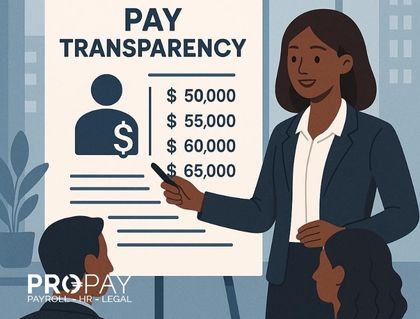EU Pay Transparency Regulation: What you need to know and do as an employer

With the upcoming deadline for transposing the EU Pay Transparency Directive, employers must prepare themselves for the requirements of this directive.
This newsletter outlines the key points of the directive and the practical steps you can already take to prepare yourself for the upcoming changes.
Regarding, the minimum wage, the recent law of 17 December 2024 has already partially transposed the EU Regulation 2022/2041 on adequate minimum wages in the EU. However, the remaining provisions are not implemented in the Belgian legislation yet which leads to uncertainties.
! Please note that Denmark, filed a case before the Court of Justice of the European Union in 2022, after the Regulation was passed by the EU, arguing that the Regulation violated the Treaty on the Functioning of the European Union. The Advocate General recommended repealing the Regulation earlier this year. The Court’s judgment and its impact for the future European legislations are expected later this year.
1. Equal pay and gender pay gap
At both the EUand Belgian level rules already exist to safeguard the right to equal pay and aim to combat discrimination between men and women.
Despite this, data from 2025 reveal significant pay gap between men and women persists. The EU Directive aims to strengthen the enforcement of existing rules and make it easier to monitor and enforce the right to equal pay.
2. Current Belgian reporting obligations
When it comes to the more specific provisions of the Pay Transparency Directive, national legislation already exists for certain employers. The Act of 22 April 2012 on combating the pay gap between men and women foresees a reporting obligation, which is one of the key elements of the EU Directive. In practice, this remains mainly a formality: employers must complete a form reporting the pay gap every two years, but this does not necessarily result in concrete actions.
3. Essential aspects of the EU Pay Transparency Directive for employers: information and reporting obligations
The aim of this Directive is clear: eliminate the gender pay gap. The Directive emphasizes the information and reporting obligations on the gender pay gap and sets a number of minimum requirements. This implies that the Belgian legislation must at least implement the obligations foreseen in the Directive or develop more far-reaching measures.
The Directive applies for employers in the public and private sectors, for all the employees with an employment agreement but also to job applicants. Any employer with at least one employee will have to comply with at least one of those obligations.
Regarding the minimum wages, the recent Act of 7 December 2024 is a partial implementation of the Directive 2022/2041 on adequate minimum wages in the European Union.
Firstly, an information requirement does exist towards both the applicants and the employees.
Important attention points are:
- Informing about the initial pay or its range. This obligation already applies before a candidate comes in for an interview;
- Prohibition from asking job applicants about their current salary ;
- Use of job vacancy with content and job titles that are gender neutral and prohibition from using discriminatory recruitment process;
- The criteria that are used to determine employees’ pay, pay levels, and pay progression need to be easily accessible to the employees. (Employers with fewer than 50 employees can be exempted from this obligation);
- Right to request and receive information on the employee’s individual pay level, broken down by sex, for categories of employees belonging to the same category;
- Informing the employees annually of their right to receive the above mentioned information;
- Prohibition to any restrictions for employees to disclose their pay. Such of clauses must be removed from the employment agreement, working regulations and other documents.
In addition to the information obligation, the Directive also includes a reporting obligation. According to the current Belgian legislation, the companies that employ more than 50 employees are already required to report general pay gap figures in Belgium. However, the Directive requires the employers to report within the various salary categories of employees, also including additional salary components.
The salary categories group consist of employees who perform “equal” or “equivalent” work. The latter is defined based on four criteria: skills, effort, responsibilities and working conditions.
This implies that, employees, employee representatives, labor inspectors and other competent institutions for equal treatment have the right to request clarifications. In this case, the employer is obliged to respond within a reasonable period of time and to find a solution if the gender pay gap differentials are not justified by objective and gender-neutral criteria.
Depending on the number of employees, a different deadline applies to this reporting requirement:
| Number of employees | Deadline | Relevant figures |
| > 250 | Yearly reporting as from 2027 | 2026 |
| > 150-249 | Triennial reporting as from 2027 | 2026 |
| > 100-149 | Triennial reporting as from 2031 | 2030 |
| < 100 | Based on national law or on voluntary basis | |
4. What can you do as an employer in preparation for the Directive?
As employer, you can already take some preparatory steps:
Pro-Pay can assist you with the following steps:
- Evaluation of the recruitment process
- Refrain from asking questions about the current salary and provide the starting salary before the interview;
- Using gender neutral and job titles and job vacancy;
- Evaluation of the current recruitment process, ensure that it is non-discriminatory;
- Train the recruitment staff;
- Invest in benchmark exercises.
- Evaluation of company practices
- Analyze clauses related to the confidentiality of the remuneration included in the employment agreement and the working regulations;
- Evaluate the criteria used to determine the remuneration, levels and development but also for the extra-legal and variable salary elements. We can assist you with analyzing your remuneration policy;
- Submit plans to the employee representatives (if applicable);
- Train HR Staff and managers.
- (For employers with more than 100 employees) Preparation of the report obligation:
- Calculation of the existing salary gaps at the company level and per category of employees;
- Identifying potential justifications for identified pay gaps;
- Draft an action plan in order to remove unjustified pay gaps.















